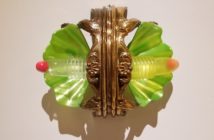Tony Smith was born Sept 23, 1912; this year he would have been 100 years old. Before he became known for making large, abstract geometric sculptures, he had owned a bookstore, had a career in architecture, studied with the art student's league, helped create the intellectual underpinnings for land art, taught, and wrote a bit. He was hard to pin down. A recessed garden, like his unrealized Haole Crater (pdf) (Haole means foreign born person), can only be described as the meeting point between architecture and land art. It was much more functional than his minimalist works, but Haole Crater real function was aesthetic; it is an important land art work that only exists as a concept. Land art sympathized with the model he created for this piece: site-specific and sensitive to local conditions.
If Sol LeWitt is to wall drawings and cubes, then Smith is to abstract sculptures based off of the tetrahedral module. As an architect and someone who had had worked in Frank Lloyd Wright's studio (on the Gunning House for one), Smith would have been familiar with people like Buckminster Fuller, who was also enamored with geometry. Bucky's geodesic domes were also based on tetrahedral shapes, even if they were more regularly spaced than Smith's sculptures. LeWitt and Fuller's works expose the fundamental detail that Smith's work was partially in response to abstract expressionism, even if it is known as being minimalism. Smith's work does not compare to the gesture and untamed emotions of a Pollock (a friend of Smith's), but it does relate to the spiritual calm of Rothko and to the trim gestures found in color field paintings. His shapes are suggestive and project into space in ways that challenge the regularity and control found in Fuller's work. These two artists, using the same geometric basis go in different directions, one abstracting it and the other using it in a rational manner.
Like many sculptures, looking at each angle of Smith's work reveals a slightly different work. They reference naturally occurring forms, created to be both formally minimalist and sculptural puns. Robert Storr said that Smith found his inspiration in "geometric forms found in nature: molecular and crystalline structures, the hexagonal grid of a beehive, the closely packed formation of bubbles." Smith titles his works (unlike many artists from his era) and he seems to always be playful with them: Generation, Duck, Smog, Throne, Smoke, Marriage, Amaryllis. They seem endless, they are not locked down to just one format—not just a noun or a verb or a series with number—they are as variable and expressive as the works they refer to and add to the viewers understanding. Untitled seems like a haughty obstruction compared to Smith's magnetic titles.
The 7000 lbs. Amaryllis, from 1965 was created in edition of 3 and were collected by the Wadsworth Atheneum, the Met, and the Walker. Just last week the Wadsworth reinstalled Amaryllis in front of their building after not having it on display since 2003. If the flower is to be found in this sculpture, it hides its petals well. The Amaryllis is a cold weather flower that blooms readily and is associated through Ovid with devotion. Emerging out of the solid base (metaphorically its bulb), this metallic flower curves, possibly towards the sun. Created of strong triangular shapes, some truncated, the sculpture seems stable and solidly connected on the ground at some angles and balanced on a knife's edge from others. The raised surface steadily grows out of its base. Depending on the angle, it forms an optical illusion, where it can seem shorter or taller as you circle it.
Smith's connection to the Wadsworth is significant; besides first showing Amaryllis at the Wadsworth, he donated a significant portion of his painting collection there, in 1964 he participated in Sam Wagstaff's Black, White, and Grey, in 1966/67 he had a joint solo show with the Wadsworth and the ICA Philadelphia, and he named the ongoing MATRIX series.
- The 1965 installation for Tony Smith: Two Exhibitions of Sculpture
- On the highway, heading to the Wadsworth.
- 2012 installation.
- A postcard showing Amaryllis before the conservation.








